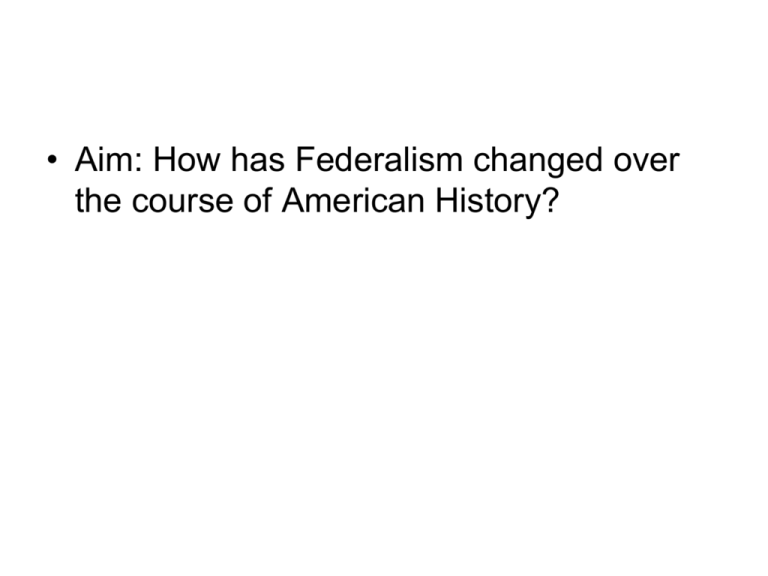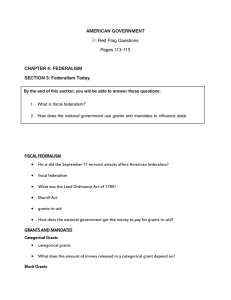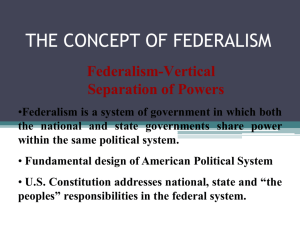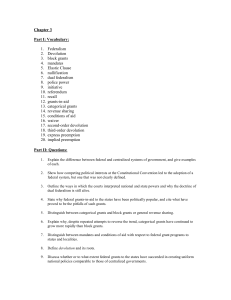Federalism 3 - Hauppauge School District
advertisement

• Aim: How has Federalism changed over the course of American History? 2 Federalisms? • OLD SCHOOL – Dual Federalism – • AKA Layer Cake Federalism – Federal and state governments remain dominant in their separate spheres of influence – A clear delineation of authority among different levels of government • NEW SCHOOL – Cooperative Federalism – • AKA – Marble Cake Federalism • State and Federal governments work together to solve complex problems • Mixing of authority and programs among national, state, and local levels Dual Federalism (Layer Cake) What about rights? • Selective Incorporation: The practice of the Supreme Court of applying guarantees of the Bill of Rights to the states through the Fourteenth Amendment – Most guarantees of the Bill of Rights have been incorporated (i.e. First Amendment Protections, Due Process) Cooperative or Marble Cake Federalism – When did it begin? • The New Deal created massive federal programs that needed to be administered on the state and local levels, but paid for on the national level. Federalism over the Past 50 Years • Creative Federalism: Lyndon Johnson’s Great Society programs caused states to rely heavily on federal funding and led to greater cooperation between the states and national govt. in administering various programs. • Competitive Federalism: Under Nixon, and later under Reagan, states would take more responsibility in administering programs, and even develop programs of their own. However, states had to meet minimum requirements and adhere to mandates. (AKA New Federalism, or Devolution) Devolution: • President Reagan, and Congress under President Clinton sought to shift responsibility to the states by increasing block grants. • Example is welfare reform: Aid to Families with Dependent Children act was replaced by the Responsibility and Work Opportunity and Reconciliation Act (Welfare Reform Act, 1996) – federal grants to states for welfare was changed from open ended entitlement to capped block grants with certain stipulations. Fiscal Federalism: • Based on the funds provided by the national government to the states, and what can be done with them. Grants in Aid Categorical Grants Block Grants Revenue Sharing Mandates • Grants: Money given to states by the federal government • Categorical grants-in-aid: Federal grants for specific purposes, i.e. building an airport • Block Grants: money given to states for programs in certain areas, but with much broader guidelines • Revenue Sharing: Federal sharing of a fixed % of its revenue with the states • In general, grants reflect national concerns: education, crime, drug abuse, pollution What types of Fiscal Federalism would best be applied to the situation in this cartoon? Supremacy of the Federal Govt. • Federal Control is maintained through conditions of aid and mandates – That is, a state must do what the Federal govt. wants in order to receive money • Categorical grants have increased at a greater rate than block grants Federal Power Applied to States • • • Americans With Disabilities Act- Bans discrimination based on physical disability, reasonable accommodations must be made, access to public facilities Civil Rights Act 1964 – Applied Federal rules of antidiscrimination to states (equal accommodations, banned literacy tests, desegregation, banned discrimination in employment) Clean Air Act – Enforces minimum clean air standards for pollution and auto emissions across the nation. States may go beyond the minimum. Lobbying for Federal Money • states actually lobby for federal money and compete: i.e. Sunbelt v. Frostbelt • States keep offices in Washington for purpose of lobbying Intergovernmental Lobby: U.S. Conference of Mayors National Governors Association National Association of Counties National League of Cities National Conference of State Legislators International City/County Management Association • They all read “Governing Magazine”








